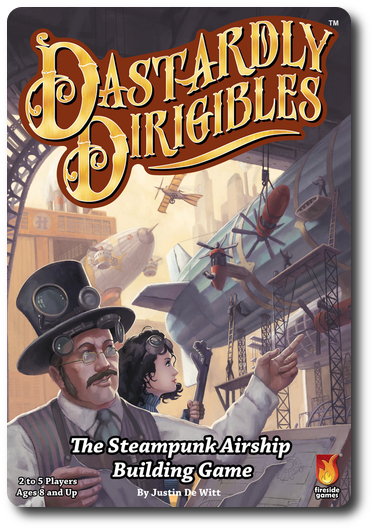
The Basics:
- For ages 8 and up
- For 2 to 5 players
- Approximately 60 minutes to complete
Geek Skills:
- Active Listening & Communication
- Counting & Math
- Logical & Critical Decision-Making
- Reading
- Pattern/Color Matching
- Strategy & Tactics
- Hand/Resource Management
Learning Curve:
- Child – Easy
- Adult – Easy
Theme & Narrative:
- Build your flying ship as fast as you can before you fall flat on your face
Endorsements:
- Gamer Geek approved!
- Parent Geek approved!
- Child Geek approved!
Overview
The greatest airship engineer in history is retiring. Before he leaves the public spotlight and enjoys the rest of his years in solitude, he must name a successor. You are a prominent airship engineer in your own right, but an endorsement from the greatest engineer in the world would ensure your place in history. Now you just have to prove yourself and beat the competition.
Dastardly Dirigibles, designed by Justin De Witt and published by Fireside Games, is comprised of 5 Guide sheets, 63 Airship Part cards (9 different suits, seven airship parts per suit), and 12 Special cards. The cards are as thick and as durable as your standard playing card. The Guide sheet is made of glossy paper. Not included with the game, but necessary to play, is a pen or pencil and a pad of paper to keep track of players’ scores.
Preparing to Build
To set up the game, first give each player a Guide sheet. These are placed in front of each player and visible to everyone at the table. Place any Guide sheets not used back in the game box.
Second, shuffle all the cards together and deal 5 to each player, face-down.
Third, take the remaining cards and place them face-down in a stack in the middle of the playing area to create the draw deck. Leave room for a discard pile.
Fourth, have each player draw one card from the draw deck and place it face-up in a row. This row is referred to as the “Emporium.”
That’s it for the game set up. The player who drew an airship piece that is closest to the nose of the airship (front) is the first player.
Gears, Knobs, and Special Stuff
There are two types of cards in the game. These are Airship Parts and Special cards. These can be found in the Emporium and initially in the player’s hand. Understanding how each card type is used is crucial to victory. Each type is summarized here.
Airship Parts
There are seven different Airship Part cards, each representing a major section of the airship the players are attempting to build. There are nine suits in total, where each suit accounts for a specific airship build theme, but each Airship Part card is interchangeable and can be used with different suits.
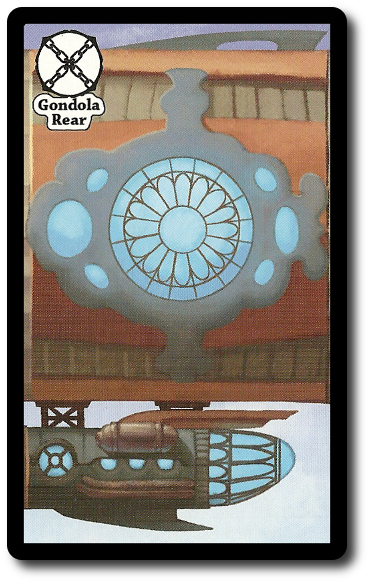
The Airship Part cards, from front to back, include:
- Nose Cone
- Lift Engine
- Gondola Front
- Gondola Rear
- Drive Engine
- Lift Engine
- Tail
The nine suits are as follows:
- Chain
- Gear
- Goggles
- Key
- Screw
- Top Hat
- Wrench
Also, there is a “Wild” suit which is not considered a suit in and of itself but can represent any of the other nine suits.

Special Cards
Special cards introduce new effects and temporarily give a player an advantage. They are played from the player’s hand to the discard pile after they are resolved. While each Special card can help a player out, they are not so powerful as to give the player a significant advantage. Think of them as more like slight speed boosts in a race. They will help a player get ahead, but cannot help a player maintain their lead indefinitely.
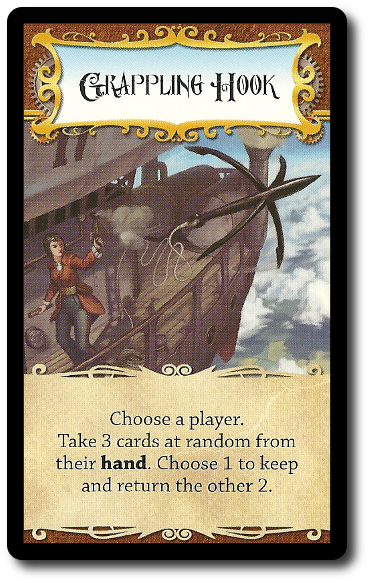
Assembling Airships
Dastardly Dirigibles is played in 3 rounds with any number of player turns. A player’s turn during a single game round is summarized here.
Step 1: Draw Cards
The first thing a player does is draw cards from the draw deck or from the Emporium to bring their hand size back up to no more than five cards. If the player draws from the Emporium, a new card is taken from the draw deck to replaced the Emporium card. If the player already had five or more cards, they skip this step.
Step 2: Perform Up to Three Actions
The player can now take up to 3 actions in any order they like and can repeat the same action if they so choose. The actions are as follows:
Play 1 Airship or Special Card
The player can play 1 Airship Part card or 1 Special card from their hand. If the player plays a Special card, it’s resolved and then discarded. Playing Airship Part cards is a bit more involved.
Each Airship Part card represents 1 of 7 possible parts that make up a whole airship. The players use their Guide sheet to help them keep track of what parts they have built and what parts they still need to acquire. An airship need not be built using a single suit or using specific Airship Parts in a particular sequence
Players play their Airship Part cards to their Guide sheet. If the space is empty, the card remains. If the space already has an Airship Part, then the previously played one is discarded, and the new one takes its place.
As soon as the player plays an Airship Part card, all of the player’s opponents must play a matching Airship Part card to their Guide sheet, but it need not be the same suit. The opponents can decide which Airship Part card suit they want to play if they have more than 1, but they must play at least one if they have it. This could cause them to remove previously played Airship Part cards. If an opponent doesn’t have a matching Airship Part card, they do nothing.
Discard 1 Card
The player can select one card in their hand and play it to the discard pile. This is not the same as playing a Special card for its action. The player does not draw a new card to replace the one they discarded.
Swap 1 Card with Emporium
The player takes one card in the Emporium and adds it to their hand. Then the player takes any other card in their hand and places it in the Emporium.
Replace Emporium
The player takes all the cards in the Emporium and discards them. Then the player draws one card per player to create the new Emporium.
Pass
The player can always pass which will end their turn, regardless of how many actions they have taken.
Ending a Round and Scoring
A round ends as soon as one player has completed their airship by playing 7 Airship Part cards, filling their Guide sheet. Players now calculate their score for the round by determining which suit they have the most of and scoring 2 points for each card in that suit. For example, if a player had 3 Goggles as their most played suit, they would score 6 points. If a Wild card is used to determine which suit is counted, it only provides 1 point, not 2.
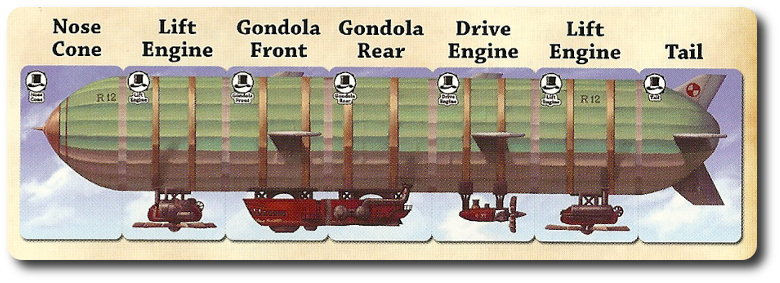
This airship, comprised of the same suit, would be worth 14 points!
Players can also attempt to score a “Muddle,” which is a complete airship made of exactly one suit each (or seven different suits). If the player can create such an airship, they score 20 points but do not receive any special bonus points.
Any player who has an incomplete airship scores 1 point per card used.
Bonus points are then scored (for everyone except those who score a Muddle).
- +2 points given to the player who completed their airship first and ended the round
- +1 point to any player who also finished their airship during the round
- If the player has the “Golden Dynamotor” in their hand when the round ends, they earn an additional +1 point
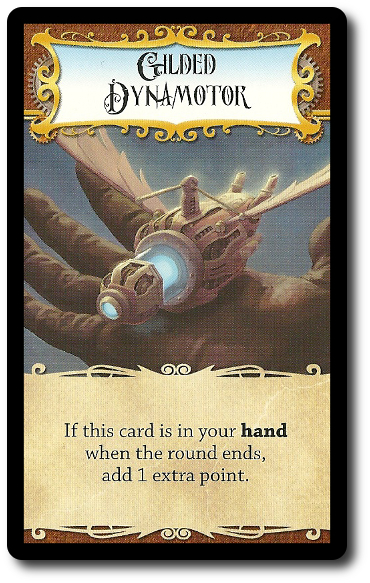
We called it the “Golden Snitch.”
New Round and Ending the Game
A new round now begins if only 1 or 2 rounds have been played so far. Setting up the new round is exactly like setting up the game for the first time. When the round is over, points are scored again.
After the 3rd round is completed, players add up all their points from all three rounds. The player with the most points wins the game.
To learn more about Dastardly Dirigibles, visit the game’s web page.
Final Word
 The Child Geeks were quick to catch on and to get to work on building their airships. Special cards were used accurately, and the subtle way the game keeps everyone going towards the end goal was not lost on even the youngest of players. According to one such Child Geek, “Each time you play a part, everyone else gets to play a part, too. This means that playing parts on your turn is not alway a good thing.” Certainly not if you are attempting to score a Muddle or working on individual suits. However, this was seen as a very good thing by all the Child Geeks. As one Child Geek put it, “The game wants you to move forward and helps you by allowing you to play cards out of turn. You just have to make sure you don’t overplay your cards and hurt your airship.” Even though the game does want you to move forward, it helps you for a price. A price, I might add, that the Child Geeks were happy to pay. All the Child Geeks voted to approve Dastardly Dirigibles.
The Child Geeks were quick to catch on and to get to work on building their airships. Special cards were used accurately, and the subtle way the game keeps everyone going towards the end goal was not lost on even the youngest of players. According to one such Child Geek, “Each time you play a part, everyone else gets to play a part, too. This means that playing parts on your turn is not alway a good thing.” Certainly not if you are attempting to score a Muddle or working on individual suits. However, this was seen as a very good thing by all the Child Geeks. As one Child Geek put it, “The game wants you to move forward and helps you by allowing you to play cards out of turn. You just have to make sure you don’t overplay your cards and hurt your airship.” Even though the game does want you to move forward, it helps you for a price. A price, I might add, that the Child Geeks were happy to pay. All the Child Geeks voted to approve Dastardly Dirigibles.
 The Parent Geeks enjoyed the game, as well, although a few of the non-gamer non-geeky Parent Geeks had no real idea what Steampunk was, making the game’s setting a bit odd. As one such Parent Geek put it, “Why does my airship have all these pipes and fins? That’s not a good idea for an airship.” Even though the construction of the airships was seen by most as “questionable” with the hodgepodge of parts thrown together, all the Parent Geeks agreed on one thing: the game was a lot of fun. As one Parent Geek put it, “A fast game that seems a lot shorter than the hour you put into it.” Another Parent Geek said, “I like how the game subtly opens up to you. I thought it was just a race, but now I see it has more to do with pacing and positioning than anything else.” When the games were over, the Parent Geeks voted to approve Dastardly Dirigibles.
The Parent Geeks enjoyed the game, as well, although a few of the non-gamer non-geeky Parent Geeks had no real idea what Steampunk was, making the game’s setting a bit odd. As one such Parent Geek put it, “Why does my airship have all these pipes and fins? That’s not a good idea for an airship.” Even though the construction of the airships was seen by most as “questionable” with the hodgepodge of parts thrown together, all the Parent Geeks agreed on one thing: the game was a lot of fun. As one Parent Geek put it, “A fast game that seems a lot shorter than the hour you put into it.” Another Parent Geek said, “I like how the game subtly opens up to you. I thought it was just a race, but now I see it has more to do with pacing and positioning than anything else.” When the games were over, the Parent Geeks voted to approve Dastardly Dirigibles.
 The Gamer Geeks couldn’t put their finger on it, but the game felt very familiar to them. As one Gamer Geek put it, “I don’t know what it is, but there’s something about this game that makes me think I’ve played it or something like it before.” Not that it mattered, as the game entertained the Gamer Geeks. According to one Gamer Geek, “This is a solid game. Light but it has depth. You need to be strategic about your card playing timing and always have a backup plan.” Another Gamer Geek said, “A fun game. I’d play this as a filler or even as the main game for the evening if I was short on time and didn’t want to spend a lot of mental energy on a heavier game.” When the votes were in, the Gamer Geeks approved Dastardly Dirigibles, finding it to be a game that could definitely hold their interest.
The Gamer Geeks couldn’t put their finger on it, but the game felt very familiar to them. As one Gamer Geek put it, “I don’t know what it is, but there’s something about this game that makes me think I’ve played it or something like it before.” Not that it mattered, as the game entertained the Gamer Geeks. According to one Gamer Geek, “This is a solid game. Light but it has depth. You need to be strategic about your card playing timing and always have a backup plan.” Another Gamer Geek said, “A fun game. I’d play this as a filler or even as the main game for the evening if I was short on time and didn’t want to spend a lot of mental energy on a heavier game.” When the votes were in, the Gamer Geeks approved Dastardly Dirigibles, finding it to be a game that could definitely hold their interest.
 Dastardly Dirigibles is deceptively simple. The gameplay is very straight forward, and it would appear that it doesn’t want to leave any player in the dust. But don’t be fooled. The game doesn’t care one bit for the players and here’s why. It forces actions and reactions, making players take steps doing things they normally wouldn’t want to do. The game forces players to play cards, but it does it in such a way as to make it feel like it’s doing you a favor.
Dastardly Dirigibles is deceptively simple. The gameplay is very straight forward, and it would appear that it doesn’t want to leave any player in the dust. But don’t be fooled. The game doesn’t care one bit for the players and here’s why. It forces actions and reactions, making players take steps doing things they normally wouldn’t want to do. The game forces players to play cards, but it does it in such a way as to make it feel like it’s doing you a favor.
“What’s this? Your opponent just played an engine? Guess what? You can, too! Yeah, we’re all winners!”
The game just sold you a beautiful lie, and you’ll buy it each and every time, too, with a smile. When you are forced to play a card, you are also forced to change your Guide sheet in a way you may not particularly want.
The key to gain back control is card management. When the game first starts, you want to have as many Airship Part cards as you can. If cards are replaced, you’re not hurting from the forced play. Later in the game, you want to ditch as many Airship Part cards as possible and stick to Special cards. This will limit the number of forced changes you will need to make on your opponents’ turns.
I was very happy with Dastardly Dirigibles. I think the name is a bit misleading as it suggests that the players will be doing a lot of backstabbing and negative manipulation. That’s not the case here, as the game rules require players to always act and react, leaving it feeling like it’s part of the natural order of things and somewhat cooperative. Regardless, the game has teeth, and you strangely like being bit by it. Do take this game for a test flight.
This game was given to Father Geek as a review copy. Father Geek was not paid, bribed, wined, dined, or threatened in vain hopes of influencing this review. Such is the statuesque and legendary integrity of Father Geek.



